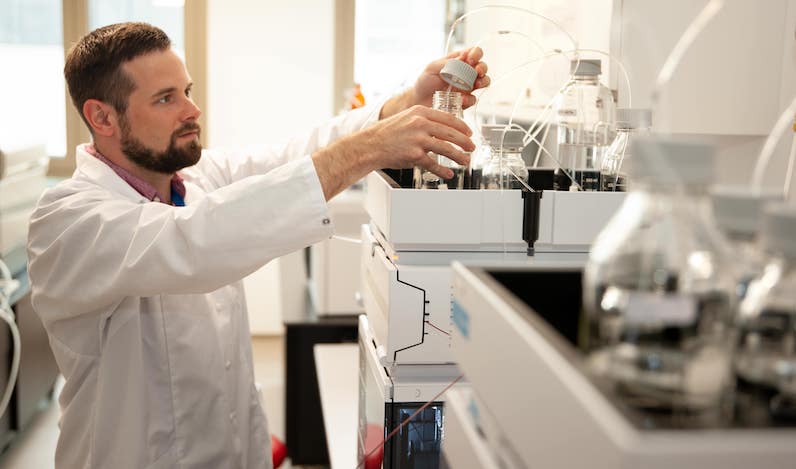New building methods and materials, as well as the trend towards sustainable buildings for living and working, have sharply increased the demand for indoor air analysis and certification.
“OETI – Institute for Ecology, Technology and Innovation” was early to recognise these demands and is a pioneer in the certification of indoor air standards in Austria with its CLEANAIR certification based on the “CLEANAIR” quality standard. Furthermore, with regard to emissions analysis, the company has once again been accredited under ISO 16000 Part 2, 3, 6, 9, and 11, as well as EN 16516.
According to studies, most people in Europe and the USA spend almost 90 percent of their lifetime in indoor spaces. This trend has meant that builders and planners are focussing even more attention on building residences and workplaces that are free from hazardous substances.
At the same time, there are differing parameters for measuring indoor air. One of these is the emissions, i.e. the release of materials into the environment from a source – for example a building material, explains engineer Rolanda Ratkic, technical expert in the field of emissions analysis and innovation in the Analytics/Chemical Laboratory at OETI. “The lower the emission mass flows of volatile organic and odour-active substances from the installed products, the higher the certainty that there is a low indoor concentration of volatile organic compounds, and odourless indoor air predominates”.
OETI – Institute for Ecology, Technology and Innovation has moved!
Comprehensive service under one roof
The CLEANAIR certification system is suitable for rooms and buildings in public and private areas. It describes the requirements for indoor air in relation to smell, volatile organic compound content, carcinogens in EU categories 1 and 2 (EU Directive 67/548/EEC) and formaldehyde in new or renovated indoor spaces ready for occupation after the completion of all onsite works and/or interior design work before handover to the user.
The expert explains that these parameters should be tested during construction or renovation, or when builders carry out standard tests on existing properties, for example on behalf of BIG [the Austrian government’s real estate management company], banks, office planners or founders of educational or care facilities. “We have decades of experience in odour assessments onsite, as well as in indoor air analysis for formaldehyde or volatile organic compounds (VOC)”.
Hundreds of different organic compounds analysed
Since March 2021, experts at OETI have been testing in their new laboratory spaces in Vienna using the very latest technical equipment. Besides the direct sampling of indoor air, one special feature is the emissions chambers. Here, the source of the emission can be pinpointed, for example by placing different building materials into the chamber and measuring the emissions directly.
During the emissions analysis, hundreds of different analytes – i.e. chemical compounds – can be identified according to ISO 16000 Part 6 and/or Part 3, explains Rolanda Ratkic: “According to the World Health Organisation WHO, volatile organic compounds in the air are categorised by their boiling point and/or their resulting volatility.
This includes solvents, dyes, varnishes, adhesives and levelling compounds. Whether these materials pollute the air is first tested in the spaces onsite by taking a sample. This is then heated in the laboratory using thermal desorption, and analysed using GC-MS (gas chromatograph with mass spectrometer) and/or HPLC (high-performance liquid chromatography)”.
High demand for indoor air certification
It is pretty clear to the expert why these certifications are increasingly in demand. “It’s not only builders who place great value on sustainable solutions during construction; it’s also end consumers, i.e. renters, buyers or owners. Today, they want increased testing to be sure that low-emission products have been used and that indoor air quality is healthy and good. The CLEANAIR certification confirms these comprehensive measurements and guarantees their validity to the customer”.
Austrian real estate developer “wohngut Bauträger Gmbh”, which has been certified with the CLEANAIR standard for a while now, represents modern and affordable build quality, personalised support through the planning process and a professional and careful handover.
OETI presents: “INSPECTED QUALITY for MOUTH-NOSE MASKS”
Wohngut Bauträger GmbH has this to say about the cooperation: “We have always placed great value on using products and materials that are free from harmful substances, precisely because the topic of allergens is becoming increasingly important to end users.
When we heard about this certification that enables the general contractor to demonstrate an additional quality assessment, we immediately took this on board. It is also a benefit for onsite building inspection because the values are presented all together and products can be better monitored”. Indoor air certification has already become a component in the developer’s tendering.
“Awareness of environmental choices has generally become more prevalent. It started with food and is extending to the topics of building and living. End users, too, are noticing that there are more and more certifications, so they are becoming more in demand. I think this trend will continue in the future”.































